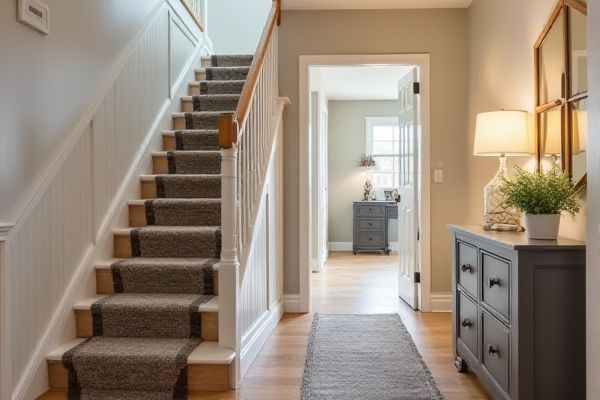
Choosing between a hallway runner and a stair runner depends on your home's traffic flow and safety needs, as hallway runners protect flooring while stair runners provide traction and reduce noise on stairs. Explore this article to understand which runner best suits your space and lifestyle.
Table of Comparison
| Feature | Hallway Runner | Stair Runner |
|---|---|---|
| Purpose | Protects and decorates hallway floors | Provides traction and cushions stairs |
| Dimensions | Long and narrow, fits hallway length and width | Narrow strips running the length of stair treads |
| Durability | Moderate, withstands foot traffic | High, designed for constant impact and wear |
| Installation | Laid flat, secured with tape or tack strips | Secured with stair rods, staples, or adhesive |
| Safety | Reduces slipping in hallways | Enhances stair safety by preventing slips |
| Design Options | Wide variety of patterns and colors | Often tailored to stair dimensions and style |
| Maintenance | Vacuum and periodic cleaning | Frequent cleaning due to high wear areas |
Introduction to Hallway and Stair Runners
Hallway runners and stair runners are popular choices for adding style, comfort, and protection to high-traffic areas in your home. Hallway runners are long, narrow rugs designed to cover and protect flooring along corridors, while stair runners are specifically crafted to fit the stairs' shape, enhancing safety and reducing noise. Choosing the right runner depends on your space's dimensions and traffic patterns, ensuring durability and aesthetic appeal.
Key Differences Between Hallway and Stair Runners
Hallway runners are designed for flat, elongated spaces with a focus on durability and ease of cleaning, typically measuring wider to cover more floor area. Stair runners prioritize safety, featuring reinforced backing and non-slip properties to secure each step, often narrower to fit stair treads precisely. Both types differ in installation technique, with stair runners requiring precise stapling or tacking on each stair compared to simpler hallway installations.
Material Options for Hallway vs Stair Runners
Hallway runners often utilize durable materials like nylon, polyester, or wool blends designed to withstand high foot traffic and resist stains, ensuring longevity and easy maintenance. Stair runners prioritize materials with excellent grip and resilience, such as wool or synthetic fibers with textured weaves to enhance safety and prevent slipping on steps. Choosing the right material for Your hallway or stair runner balances aesthetics, durability, and functionality tailored to each specific area's demands.
Installation Process: Hallway Runner vs Stair Runner
Hallway runner installation involves securing a single, continuous carpet strip to a flat, even surface using tack strips or adhesive, allowing for straightforward alignment and stretching. Stair runner installation requires precise measurement and cutting to fit each stair tread and riser, with careful nailing or stapling along edges and the use of stair rods or adhesive to ensure durability and safety. The complexity of stair runner installation is higher due to the multiple angle adjustments and the need for reinforced attachment methods on vertical surfaces.
Cost Comparison: Hallway and Stair Runners
Hallway runners typically cost between $3 and $15 per square foot depending on material and length, often making them more budget-friendly than stair runners, which range from $5 to $20 per step due to specialized installation and added durability requirements. Your overall investment in a stair runner may increase because of the need for custom fitting, padding, and professional labor to ensure safety and aesthetic appeal on each step. Choosing the right option depends on your space and budget, with hallways favoring larger, continuous coverage and stairs demanding precise, high-quality materials and installation.
Design and Aesthetic Considerations
Hallway runners and stair runners both enhance your home's visual appeal but serve different design purposes due to their placement and functionality. Hallway runners typically emphasize length and pattern continuity to create a seamless flow, while stair runners focus on durability and safety with textured materials and narrow width fitting the risers and treads. Choosing the right runner depends on matching your style preference with the architectural features of your space, ensuring both aesthetic harmony and practical use.
Durability and Maintenance
Hallway runners and stair runners differ significantly in durability and maintenance due to their unique usage patterns. Stair runners endure higher foot traffic and more friction, requiring materials with superior abrasion resistance and more frequent upkeep, while hallway runners typically face steadier wear with less impact, allowing for easier cleaning and longer-lasting appearance. Your choice should consider the specific demands of staircases versus hallways to ensure both durability and manageable maintenance.
Safety and Functionality
Hallway runners provide a smooth, slip-resistant surface that enhances safety by reducing the risk of falls in high-traffic areas. Stair runners offer added traction on steps, preventing slips and cushioning each step to reduce impact on joints during ascent and descent. Choosing the right runner for your space ensures optimal functionality and safety tailored to your home's specific needs.
Popular Styles and Trends
Hallway runners often feature geometric patterns, floral motifs, and neutral tones that complement various interior styles, while stair runners tend to highlight durability with tightly woven materials and bold stripes or classic patterns like herringbone. Popular trends for both include eco-friendly fibers such as wool and jute, offering texture and sustainability. Recent designs emphasize seamless integration with hardwood floors, using low-pile runners to maintain safety and aesthetics in high-traffic areas.
Choosing the Right Runner for Your Space
Selecting the ideal runner involves considering traffic patterns and functionality; hallway runners are typically longer and designed for high-traffic areas, providing durability and seamless coverage. Stair runners require specialized backing and cushioning to ensure safety and reduce noise on steps, often featuring treads and risers for a tailored fit. Material choice, slip resistance, and ease of installation are crucial factors distinguishing hallway runners from stair runners to optimize both aesthetics and performance in your space.
 homyna.com
homyna.com